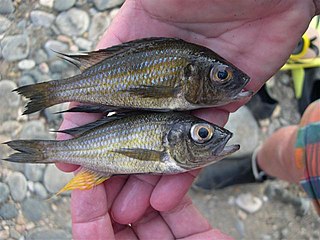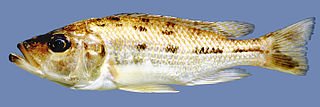
Cichlids are fish from the family Cichlidae in the order Cichliformes. Traditionally Cichlids were classed in a suborder, the Labroidei, along with the wrasses (Labridae), in the order Perciformes, but molecular studies have contradicted this grouping. On the basis of fossil evidence, it first appeared in Tanzania during the Eocene epoch, about 46–45 million years ago; however, molecular clock estimates have placed the family's origin as far back as 67 million years ago, during the late Cretaceous period. The closest living relative of cichlids is probably the convict blenny, and both families are classified in the 5th edition of Fishes of the World as the two families in the Cichliformes, part of the subseries Ovalentaria. This family is large, diverse, and widely dispersed. At least 1,650 species have been scientifically described, making it one of the largest vertebrate families. New species are discovered annually, and many species remain undescribed. The actual number of species is therefore unknown, with estimates varying between 2,000 and 3,000.

Lake Tanganyika is an African Great Lake. It is the second-oldest freshwater lake in the world, the second-largest by volume, and the second deepest, in all cases after Lake Baikal in Siberia. It is the world's longest freshwater lake. The lake is shared among four countries—Tanzania, the Democratic Republic of the Congo, Burundi, and Zambia—with Tanzania (46%) and the DRC (40%) possessing the majority of the lake. It drains into the Congo River system and ultimately into the Atlantic Ocean.
This glossary of ichthyology is a list of definitions of terms and concepts used in ichthyology, the study of fishes.

Callochromis is a genus of cichlids native to shallow, sandy bottom areas of Lake Tanganyika in East Africa. As sandsifters, all species eat sand-dwelling invertebrates. Unlike many other sandsifters, Callochromis species are somewhat aggressive, especially when breeding. C. pleurospilus has become popular with fishkeeping hobbyists because of their compact size, iridescent colors, and hardiness.

Aulonocranus dewindti is a species of cichlid endemic to Lake Tanganyika and some rivers which flow into it.

The haplochromine cichlids are a tribe of cichlids in subfamily Pseudocrenilabrinae called Haplochromini. This group includes the type genus (Haplochromis) plus a number of closely related genera such as Aulonocara, Astatotilapia, and Chilotilapia. They are endemic to eastern, southern and northern Africa, except for Astatotilapia flaviijosephi in the Middle East. A common name in a scientific context is East African cichlids – while they are not restricted to that region, they are the dominant Cichlidae there. This tribe was extensively studied by Ethelwynn Trewavas, who made major reviews in 1935 and 1989, at the beginning and at the end of her career in ichthyology. Even today, numerous new species are being described each year.

Synodontis is the largest genus of mochokid catfishes. It is the biggest genus within the 10 genera and 190 different species in the family Mochokidae. Synodontis has over 131 different species within the genus. Synodontis are also known as squeakers, due to their ability to make stridulatory sounds through their pectoral fin spines when handled or disturbed. Synodontis make a sound that sounds like squeaking by rubbing their spines together. They do this when they have been frightened or when they become angry. Synodontis may also squeak when they are taken out of the water. These catfish are small- to medium-sized fish with many species exhibiting attractive spotted markings. Some species are also known for naturally swimming belly-up, earning the name upside-down catfish. Some of these species are Synodontis contractus and Synodontis nigriventris. While some of these species are known to swim upside down, another species, Synodontis multipunctatus, is a brood parasitic cuckoo catfish,there are two other species Synodontis petricola and Synodontis grandiops are also called brood parasitic cuckoo catfish.

Paedophagy in its general form is the feeding behaviour of fish or other animals whose diet is partially, or primarily the eggs or larvae of other animals. However, P. H. Greenwood, who was the first to describe paedophagia, defines it to be a feeding behaviour evolved among cichlid fishes.

Rhamphochromis is a genus of East African haplochromine cichlids endemic to the Lake Malawi basin, also including Lake Malombe, Lake Chilingali, Chia Lagoon and upper Shire River. They mainly occur in offshore open waters, but a few species also near the coast. They are piscivores that typically feed on lake sardines and small utaka cichlids.

Hemitaeniochromis is a small genus of cichlid fishes endemic to Lake Malawi in east Africa. The genus is distinguished from other genera of Lake Malawi Haplochromini by details of its melanic color pattern and by its dentition. The color pattern includes (1) a midlateral horizontal stripe starting at least an eye length behind the operculum, this stripe broken into separate spots at least on its front half, more nearly continuous on its rear half, extending to the end of the caudal peduncle; (2) a second (supralateral) stripe above the midlateral one that is only on the front part of the flanks, and which is also at least partly broken into spots; (3) above this at the base of the dorsal fin are 4 or 5 dorsal midline spots. The dentition of the jaws is also distinctive in fish at least 10 centimetres in length ; the outer teeth are roughly conical with a single cusp and are spaced apart from each other by about the width of the tooth.
Trematochromis benthicola is a ray-finned fish species in the cichlid family (Cichlidae), subfamily Pseudocrenilabrinae and the tribe Haplochromini. It is found throughout Lake Tanganyika in the Burundian, the Democratic Republic of the Congo, Tanzanian, and Zambian shoreline. Its preferred habitat are the hidden recesses of caves in shallow water.

The convict julie is a cichlid species in the subfamily Pseudocrenilabrinae family endemic to Lake Tanganyika. Hence it is found in Burundi, the Democratic Republic of the Congo, Tanzania, and Zambia. The fish is named after Charles Tate Regan.

The zebra mbuna is a species of cichlid endemic to Lake Malawi in Africa. This species can reach a length of 11.3 cm (4.4 in). It feeds on aufwuchs, a surface layer of mostly algal material that grows on rocks. This cichlid is a mouthbrooder and the female broods the eggs in her mouth for about three weeks. This fish can sometimes be found in the aquarium trade.
Plecodus elaviae is a species of cichlid endemic to Lake Tanganyika. This schooling species is a scale-eater, plucking scales from other fishes. Both parents care for the offspring in this mouthbrooder. This fish can reach a length of 32 centimetres (13 in) TL.

Synodontis granulosus is a species of upside-down catfish endemic to the Democratic Republic of the Congo, Burundi, Zambia, and Tanzania, where it is only known from Lake Tanganyika. It was first described by Belgian-British zoologist George Albert Boulenger in 1900, from specimens collected at multiple points along the shore of Lake Tanganyika. The species name comes from the Latin word "granulum", meaning of grain, and refers to the granular papillae present on the skin of the fish's body.

Synodontis petricola, known as the cuckoo catfish, or the pygmy leopard catfish, is a species of upside-down catfish endemic to Burundi, Zambia, the Democratic Republic of the Congo, and Tanzania where it is only known from Lake Tanganyika. It was first described by Belgian ichthyologist Hubert Matthes in 1959. The species name "petricola" is derived from a combination of the Latin petra, meaning stone or rock, and the Latin cola, meaning inhabitant. This refers to the rocky environment where this species is found.

Perissodini is a tribe of African cichlids, containing three genera of freshwater fish found only in Lake Tanganyika.

Synodontis grandiops is a species of upside-down catfish endemic to the Democratic Republic of the Congo, Burundi, and Tanzania, where it is only known from Lake Tanganyika. It was first described by Jeremy John Wright and Lawrence M. Page in 2006, from specimens collected at multiple points along the shore of Lake Tanganyika. The species name is a Latinized combination of the Latin "grandi", meaning large or big, and the Greek "ops", meaning eye, a reference to the relatively large eyes of this fish.
Synodontis irsacae is a species of upside-down catfish endemic to Zambia, the Democratic Republic of the Congo, and Tanzania, where it is only known from Lake Tanganyika. It was first described by Belgian ichthyologist Hubert Matthes in 1959, from specimens collected from Lake Tanganyika at Kalundu, in what is now the Democratic Republic of the Congo. The species name " irsacae" is derived from the abbreviation "I.R.S.A.C.", or Institut pour la Recherche Scientifique en Afrique Centrale. For many years, specimens of the species were considered to be juvenile members of S. dhonti, but in 2006, J.J. Wright and L.M. Page identified unique characteristics of this species that established that they were a unique species.
The Ngorora Formation is a geological formation in Kenya preserving fossils dating to the Miocene. The uppermost member of the formation shows sign of a faunal turnover that occurred around 11 to 10.5 million years ago, coinciding with faunal changes elsewhere in the world. This turnover includes the arrival of the horse Hipparion in East Africa. The Ngorora Formation was initially mapped by G.R. Chapman in collaboration with the East African Geological Research Unit (EAGRU) and formally described by Bishop & Chapman in 1970. Major fossil finds were made in the early 1970s, with expeditions to the area recovering thousands of mammal, fish and mollusc remains alongside less common fossil material of birds and reptiles.















